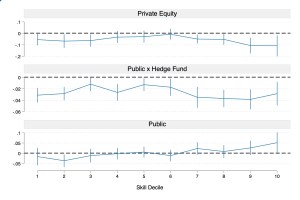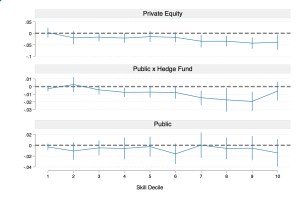Over the past 30 years, private equity firms and hedge funds have reshaped the landscape of corporate ownership. By 2022, firms under private equity management employed over 11 million people, nearly 10 percent of the U.S. workforce, while, in 2021, hedge funds managed assets exceeding a staggering $4 trillion. While the ownership structures implemented by these firms differ, they generally encourage active engagement with portfolio companies. Nevertheless, their impact on company employees is not sufficiently understood.
In a recent study, we explore whether the level or structure of compensation varies based on corporate ownership. We find that companies owned by private equity firms and hedge funds (collectively, “external active owners”) tend to provide lower and flatter compensation than peer entities for comparable work.
How do we measure comparable work? Widely available compensation data do not contain sufficient information to create “apples to apples” comparisons across organizations. We address this challenge by using proprietary data from a large compensation consultancy that is expressly intended for benchmarking purposes for its own clients. The data contain not only detailed occupational and geographic categories but also a skill measure for each role within a company. This skill measure is calculated based on intangible job requirements, including knowledge (technical, managerial, and communicative), problem-solving capabilities, discretionary power, and impact to an organization.
Analyzing over 20 million employee records from 2008 to 2018, we compare compensation for specific roles at companies under external active ownership with those at companies without such ownership, creating 199,782 comparison groups across 897 U.S. firms. We observe that employees at companies under external active ownership generally receive lower compensation. For instance, private-equity-owned companies pay 4.9 percent ($4,312) less than other privately held companies for comparable work (Figure 1).
Figure 1: Median total compensation by owner type.
We next explore how these differences manifest across the skill distribution. Figure 2 depicts the trend of compensation discount associated with external active owners across skill levels. In the figure, low-skilled workers (i.e., low-skill deciles) and high-skilled employees (i.e., high-skill deciles) are paid less at companies owned by private equity and hedge funds. These patterns hold up in more rigorous regression analyses that also control for a company’s financial performance, capital structure, and R&D investments – all factors that may influence both which companies each of these owners choose to own and employee compensation.
Figure 2: Total compensation (log) by owner type, coefficients estimated by skill level decile relative to privately held (non-PE) companies.
Moreover, our investigation reveals systematic differences in the structure of pay, not just the level. For low-skilled workers, pay differences manifest in base salary, which makes sense given that base salary comprises the bulk of compensation for these workers. However, for high-skilled workers, pay differences manifest primarily in bonuses and long-term incentives such as stocks and equity. This pattern becomes more pronounced with increasing skill level, where employees at companies under active external ownership are progressively less likely to receive bonuses and long-term incentives. In other words, high-skilled employees at these firms experience lower-powered compensation and lower ownership levels than comparable employees at other companies. Figures 3.1 and 3.2 show this effect. Relative to private companies, our baseline group, the cash to base ratio (top) and likelihood of receiving a long-term incentive grant (options or restricted shares) of any amount (bottom) is progressively lower for higher skilled employees.
Figure 3.1 — Cash to base ratio
Figure 3.2 — Likelihood of long-term incentive grant
Figure 3: Compensation structure by owner type, coefficients estimated by skill decile relative to privately held (non-PE) companies. The top panel (figure 3.1) is the ratio of cash (base salary plus bonus) to base salary. The bottom panel (figure 3.2) is the ratio of total compensation (base salary plus bonus plus long-term incentives) to base salary.
Interestingly, lower compensation does not necessarily translate into higher profitability. Even in industries that depend relatively more on cost management than innovation, we do not observe any link between paying less and higher profits for companies.
This final set of results present a puzzle: Why do companies pay less for comparable work if doing so does not lead to better performance? We consider three potential explanations. First, our findings could reflect different competencies by different types of owners. The lack of discernable performance gain from paying less could indicate that external active owners are particularly good at making companies more efficient by, in part, cutting pay. In contrast, other corporate owners may specialize in firms with strategies relying on high employee engagement that require higher compensation. Second, our findings may indicate that external active owners have an efficiency hammer where everything – including compensation – appears to be a nail. Finally, our findings could simply reflect that external active owners strive to capture more of the surplus by cutting worker pay, without necessarily considering the long-run value impact on the firm and non-owner stakeholders. We are agnostic regarding which one underlies our results.
Our research highlights that different corporate owners approach employee compensation in distinct ways. These differences are reflected in large differences in the level and structure of pay for comparable work. Before this study, a growing body of research identified a decline in labor’s share of rent, with causes such as automation, industry concentration, declining unionization, and changing managerial norms. Our results suggest an additional source of this decline: the growing share of active institutional owners and the corresponding shift in wage-setting practices within companies.
This post comes to us from Claudine Gartenberg and Elaine Pak at the Wharton School, University of Pennsylvania. It is based on their recent article, “Corporate Ownership and Employee Compensation,” available here.
 Sky Blog
Sky Blog




